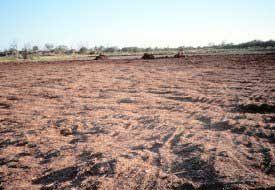
COVERING THE TAMPA BAY AND ITS WATERSHED |
Our subscribe page has moved! Please visit baysoundings.com/subscribe to submit your subscription request. |
|||||||
Bay managers are making significant strides in efforts to restore coastal habitat, meeting or exceeding key goals outlined in Tampa Bay's Comprehensive Conservation & Management Plan (CCMP). "Not only are we replacing acreage, but these projects are successful," says Brandt Henningsen, senior scientist with the Southwest Florida Water Management District's Surface Water Improvement and Management (SWIM) program. The CCMP calls for restoring 100 acres of oligohaline (low-salinity) wetlands every five years - habitat critical for juvenile fish and foraging birds. But the goal isn't simply numeric, it's predicated on restoring an optimum balance of habitats to 1950s proportions, before intensive development began. So far, progress has been good. Since 1996, local partners have restored more than 2300 acres of estuarine habitat, of which 378 are oligohaline. And these figures do not reflect the sizeable acreage awaiting restoration on lands already set aside, or healthy mangrove and marsh habitat preserved through land acquisition (another 2261 acres). By comparison, only 27 wetland acres were restored during the previous two decades from 1971 to 1989. Better still, efforts to restore vital low-salinity habitats are ahead of goal. "We're meeting or exceeding our goals," says Henningsen, "but we still have a long way to go." SWIM has spearheaded many of the wetland restoration projects. Henningsen credits the large and diverse number of organizations and agencies that have helped local restoration projects materialize and flourish. He also stresses the importance of coastal land acquisition - and the need to move quickly, cautioning against the urge to "buy it only if you can restore it now. You can't restore it if it's a WalMart. "If we're lucky, the District gets to buy one to three parcels on its priority list per year, and at the same time we're losing at least that number to development." For more information, contact Henningsen at brandt.henningsen@swfwmd.state.fl.us.
Scientists call it atmospheric deposition, but the old saying is much more telling: what goes up must come down. For Tampa Bay, that means emissions from power plants, automobiles and other industrial sources fall back on the bay or in its watershed. Approximately 21% of the nitrogen in Tampa Bay - in excess amounts, the bay's single most damaging contaminant - falls directly from the sky to the bay. Researchers estimate that atmospheric deposition is actually responsible for about half of the nitrogen in Tampa Bay, with approximately 30% of the loadings entering the bay as stormwater from contaminants deposited within the bay's watershed. Until recently, researchers attributed a majority of the nitrogen in atmospheric emissions to Tampa Electric's coal-burning power plants, including Gannon near the Port of Tampa and Big Bend near Apollo Beach. That's changed dramatically over the last few years, thanks to an agreement between Tampa Electric and government regulators. Since 1998, Tampa Electric's nitrogen oxide emissions have been cut by half - from 70,000 tons to 35,000 tons per year - along with 87% reductions in sulfur dioxide, 64% cuts in mercury and a 71% decrease in particulate matter. By 2010, emissions will be cut even further, by about 90% of 1998 levels for nitrogen and sulfur and by 73% for mercury. Four of Gannon's coal-burning units are on long-term reserve for emergency use only, and two of the units have repowered to burn clean natural gas, said Greg Nelson, Tampa Electric's director of environmental health and safety. New scrubbers have been installed at Big Bend, combustion systems have been modified, and studies are underway now to determine the best way to reduce nitrogen emissions so that all units meet the latest standards for emissions. "We were the first utility in the country to settle with the EPA instead of spending 10 years and $10 million in court," Nelson said. "We could have conceivably won, but the community would have lost that time, so we stepped up to the plate and said 'This is the right thing to do.' " The next challenge for bay managers will be auto and truck emissions, which contribute approximately 35% of the nitrogen in atmospheric emissions - and probably even more of the pollutants that actually impact Tampa Bay, said Noreen Poor, a University of South Florida professor and lead researcher for the Bay Regional Atmospheric Chemistry Experiment (BRACE). "Power plants release emissions high up in the air and the amount of nitrogen that falls back into Tampa Bay is a smaller fraction than that released from automobiles which are closer to the surface." To continue to hold the line on nitrogen loadings, more resources will need to be focused on alternative transportation, including mass transit, flexible work schedules, carpooling and increased opportunities for workers to walk and bike safely. "I see some signs of change and I'm hopeful that we'll see more changes over the next decade," Poor said. For more information, contact Poor at npoor@hsc.usf.edu or 813-974-8144.
|
||||||||
|
||||||||
|
© 2004 Bay Soundings
|
||||||||



